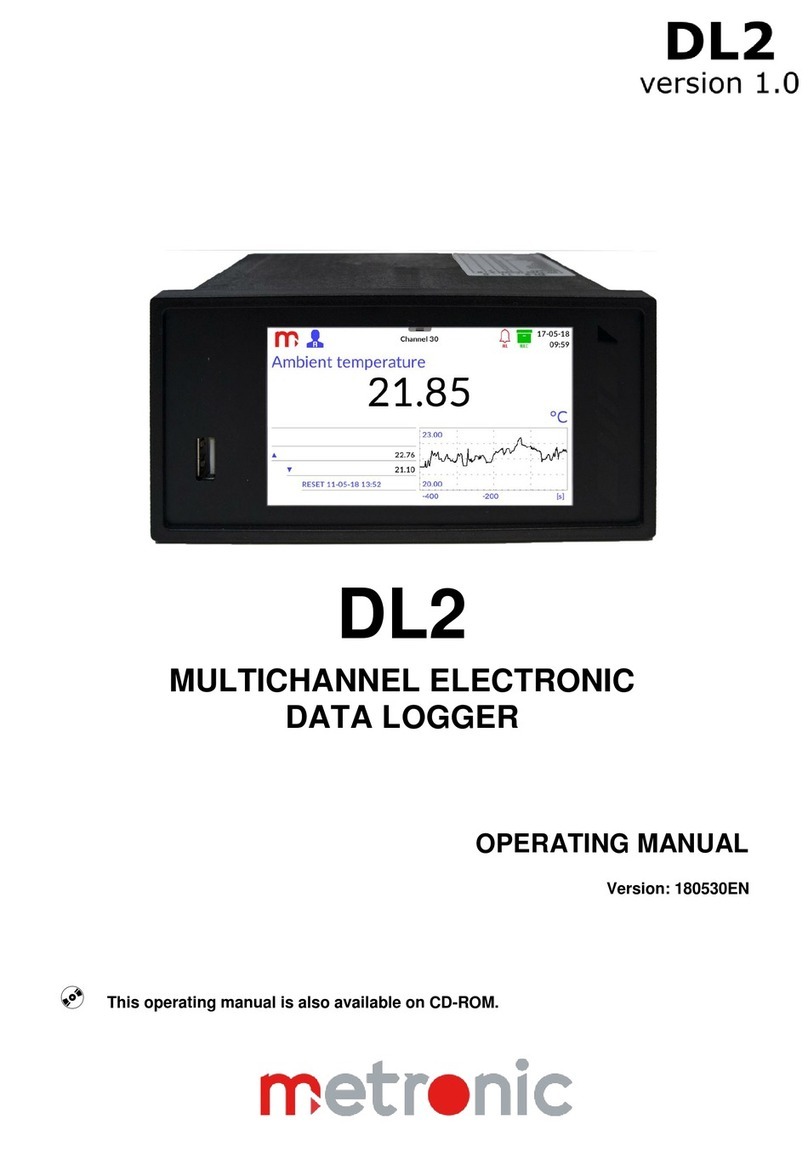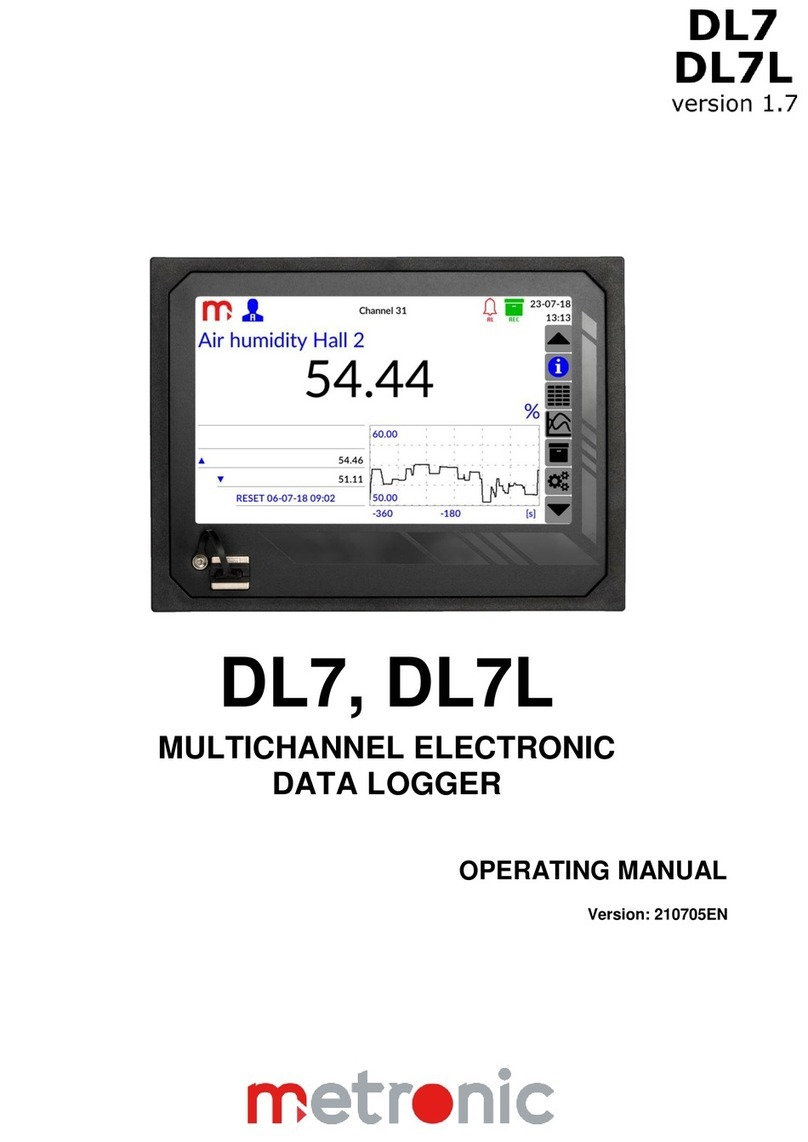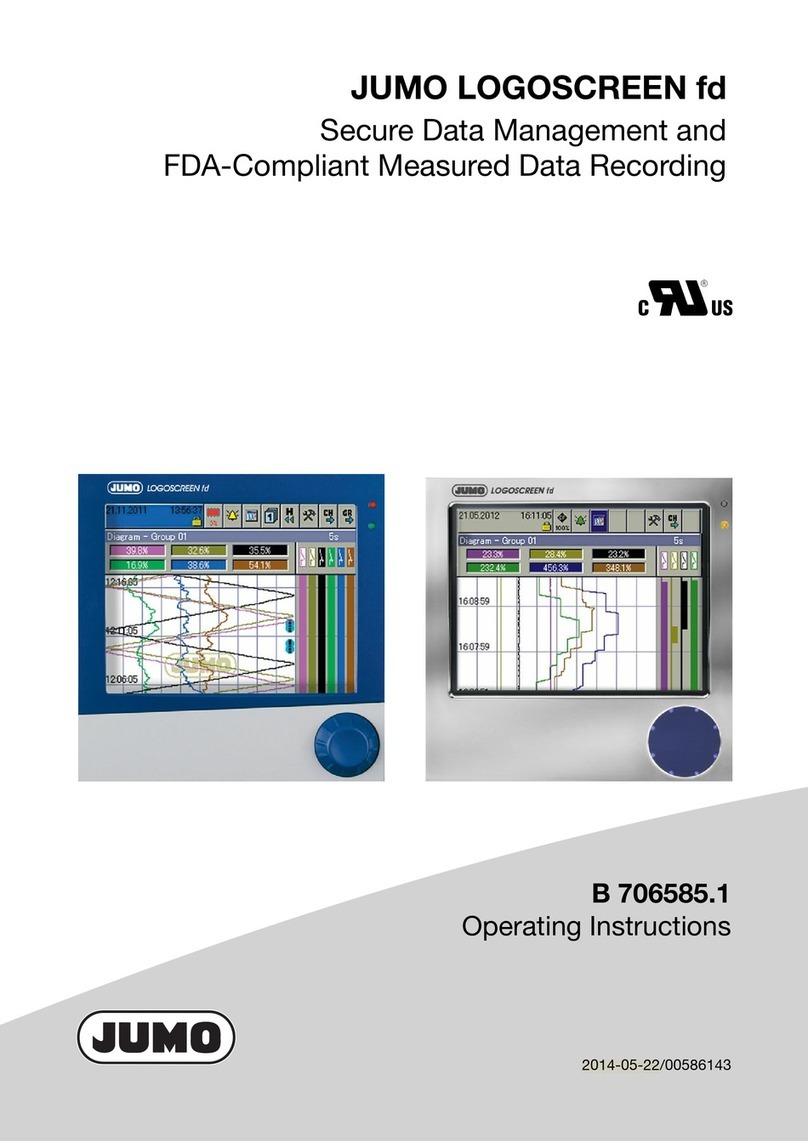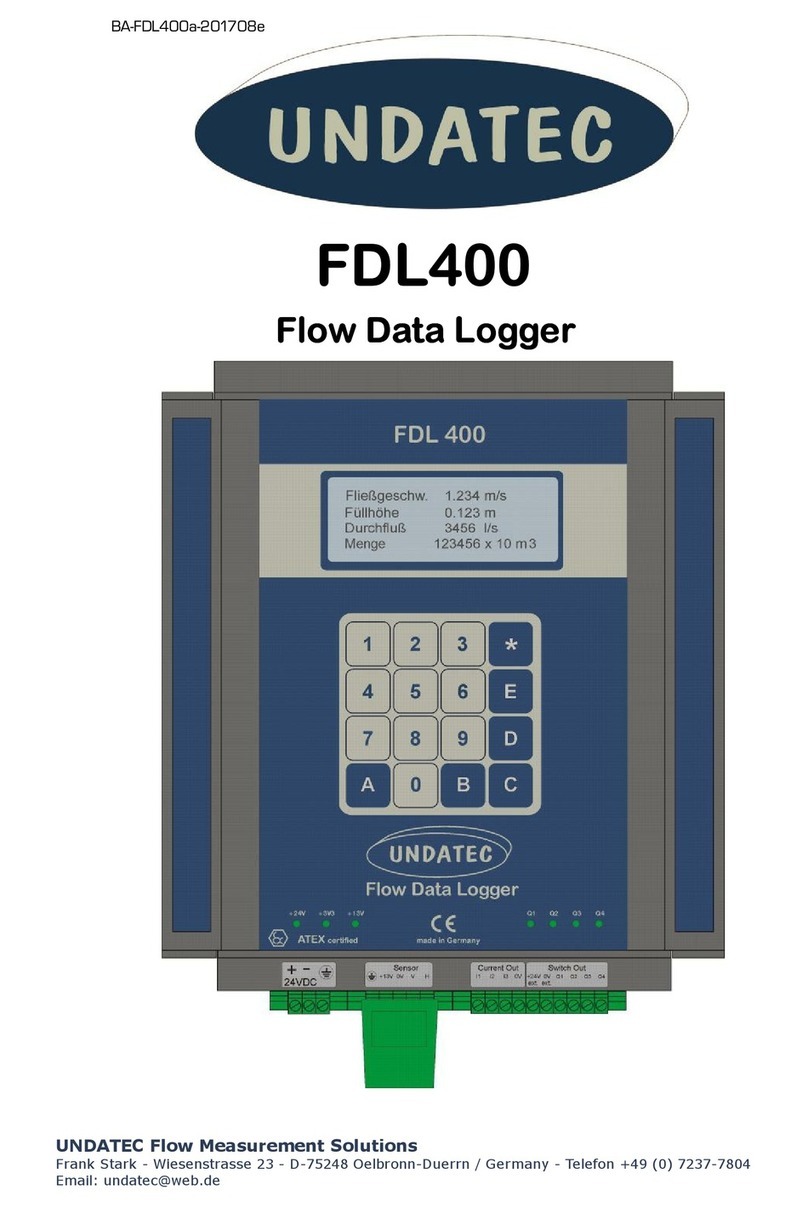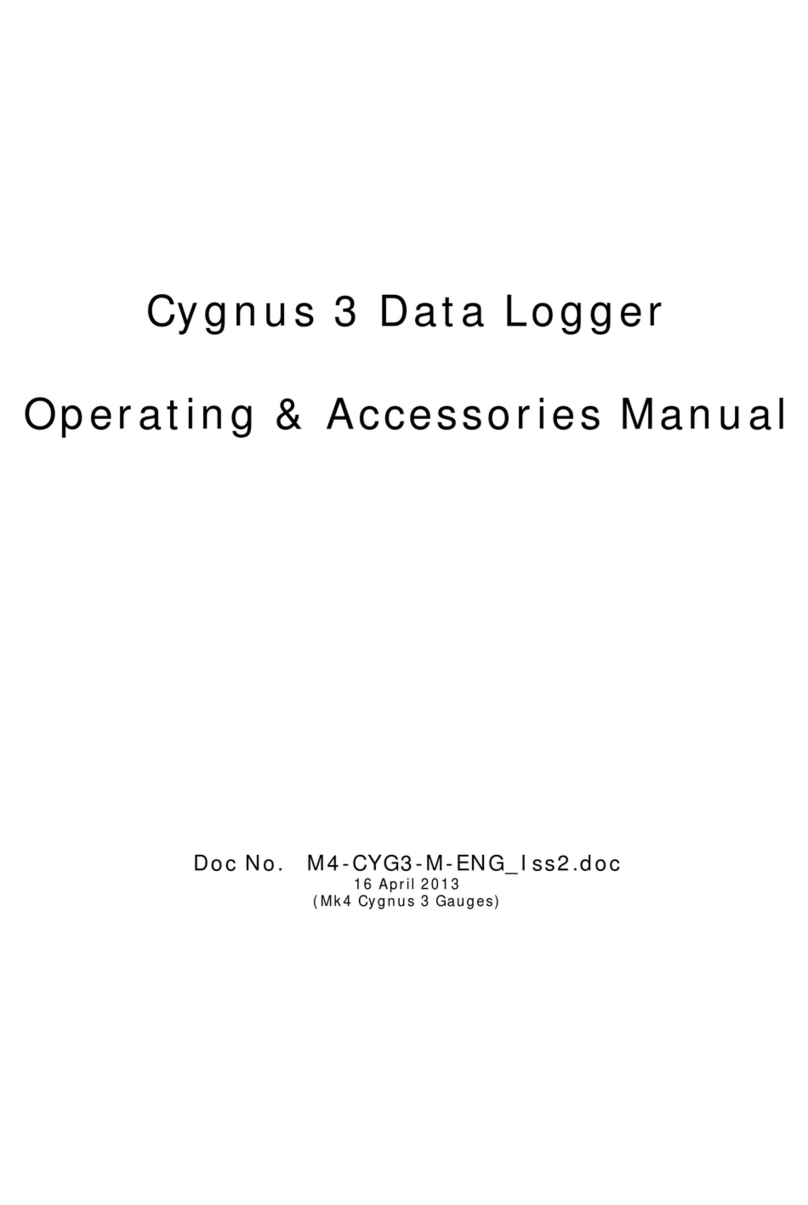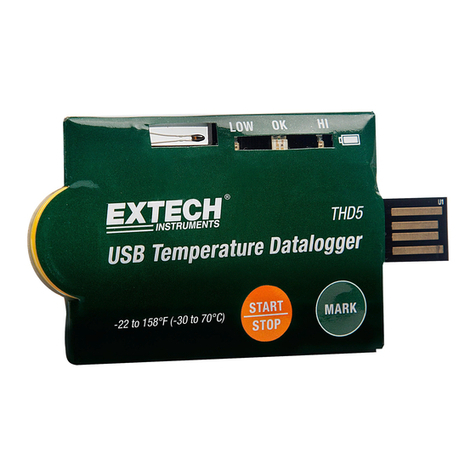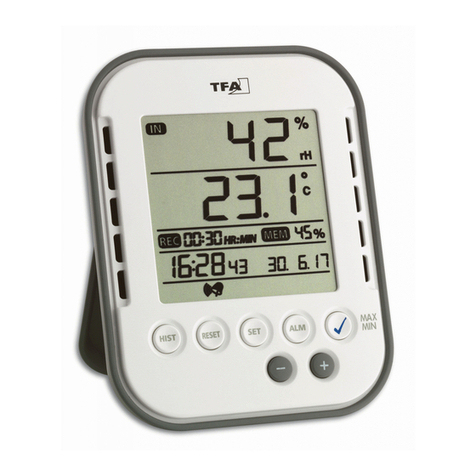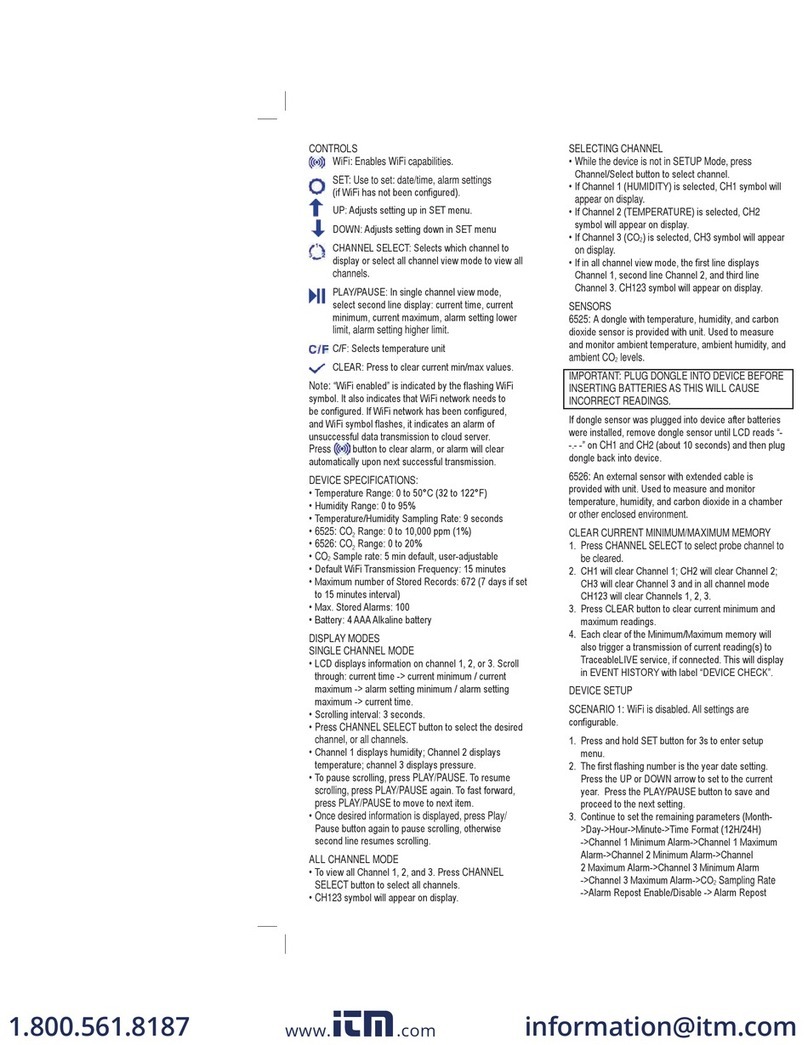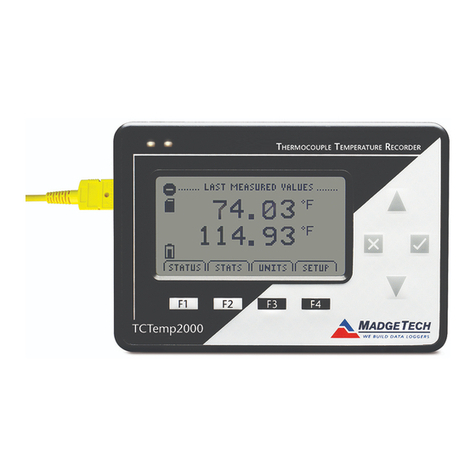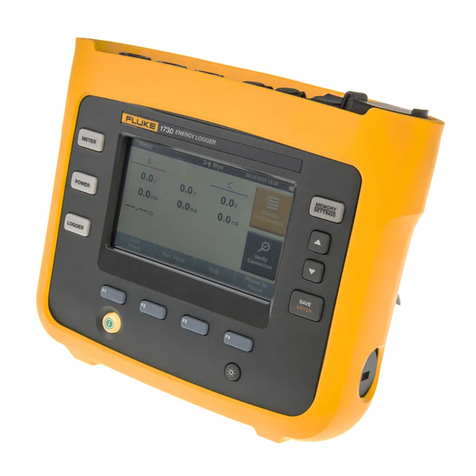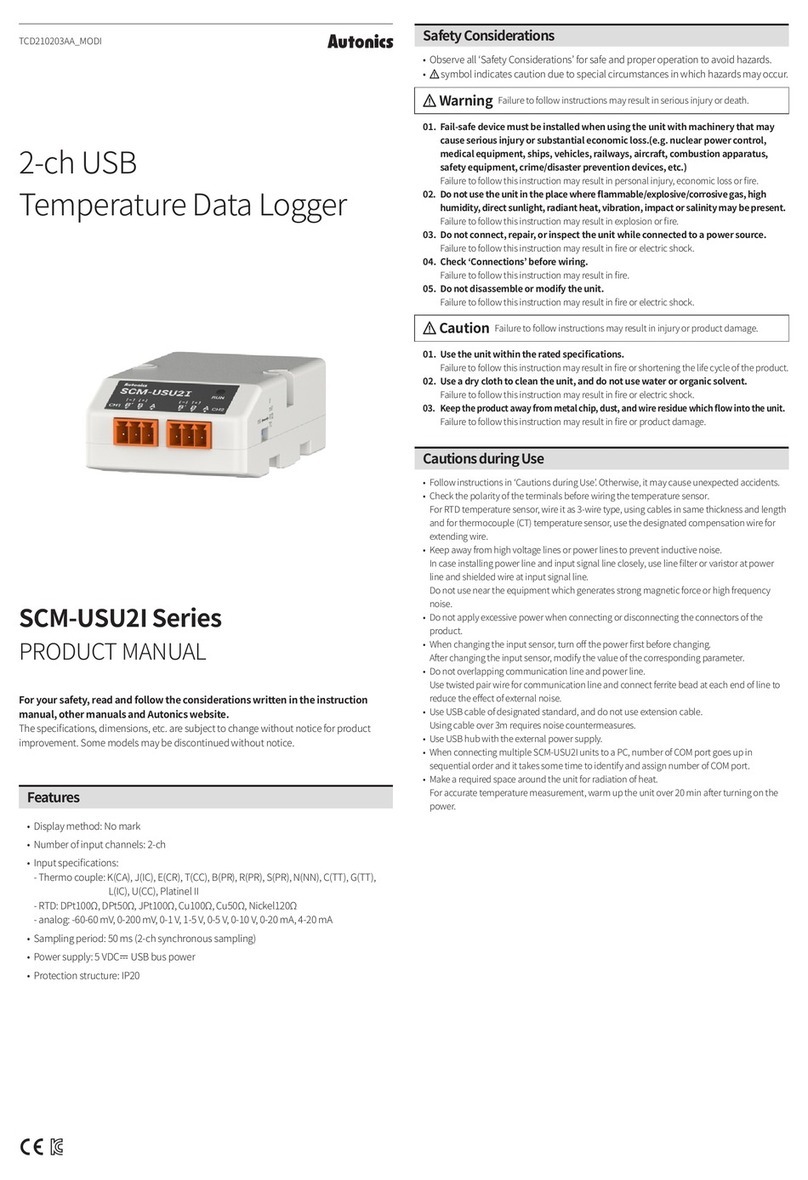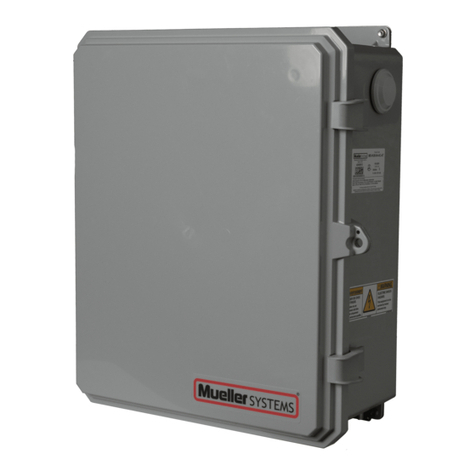Metronic DL7 Series User manual

DL7, DL7L
MULTICHANNEL ELECTRONIC
DATA LOGGER
USER’S MANUAL
Version: 180228EN

DL7, DL7L
2
Information from the Manufacturer
All functions of the recorder are subject to modifications for the benefit of
technical progress.
Before installation, carefully read all the instructions, especially those
concerned with safety.
The recorder has been manufactured according to the requirements of
relevant EU directives.
These instructions must be stored in a safe place near the installation of the
steam flow computer at all times.

DL7, DL7L
3
TABLE OF CONTENTS
1MARKING AND DOCUMENTATION........................................................................6
2SAFETY INFORMATION..........................................................................................7
3EQUIPMENT DELIVERY, HANDLING AND STORAGE........................................10
3.1 Basic components.....................................................................................................................10
3.2 Storage......................................................................................................................................10
3.3 Accessories...............................................................................................................................10
4KEY INFORMATION ABOUT THE DEVICE...........................................................11
4.1 Intended use..............................................................................................................................11
4.2 Basic functions ..........................................................................................................................11
4.3 Device Versions ........................................................................................................................12
4.4 Device configuration..................................................................................................................13
5. DL7 MODULES.......................................................................................................14
5.1 DL7 basic kit..............................................................................................................................14
5.2 Basic M module.........................................................................................................................14
5.3 The 0/4-20mA inputs modules DL7-IN6I(24V)..........................................................................14
5.4 The 0/4-20mA inputs modules DL7-IN6I...................................................................................14
5.5 The RTD inputs modules DL7-IN6RTD (DL7-IN3RTD) ............................................................14
5.6 The input module measuring the temperature and voltage mV DL7-IN6TC.............................15
5.7 The voltage input module DL7-IN6V.........................................................................................15
5.8 Universal input module DL7-IN3 ...............................................................................................15
5.9 Binary inputs module DL7-IN6D................................................................................................15
5.10 Digital Input Module (Modbus RTU) DL7-IN2RS485 (24V) ......................................................15
5.11 Digital Input Module (Modbus RTU) DL7-IN2RS485 ................................................................16
5.12 The two-state outputs module DL7-OUT6RL............................................................................16
5.13 Analogue outputs module DL7-OUT3.......................................................................................16
5. TECHNICAL DATA.................................................................................................17
RTD inputs module measuring the temperature and the resistance DL7-IN6RTD (DL7-IN3RTD) .......19
Input module measuring the temperature and voltage mV DL7-IN6TC.................................................19
Universal input module DL7-IN3 ............................................................................................................19
Voltage input module DL7-IN6V.............................................................................................................20
Analogue outputs module DL7-OUT3....................................................................................................22
7MECHANICAL INSTALLATION.............................................................................24
8ELECTRICAL INSTALLATION ..............................................................................26
8.1 Galvanic insulation in the device...............................................................................................27
8.2 DL7 modules –connection diagrams........................................................................................27
8.3 Power connection......................................................................................................................33
8.4 Connection of RS-485 data transmission line...........................................................................33

DL7, DL7L
4
8.5 Port Ethernet .............................................................................................................................33
9DISPLAY STRUCTURE AND MAIN FUNCTION KEYS.........................................34
9.1 Face plate..................................................................................................................................34
9.1.1 Title strip...............................................................................................................................34
9.1.2 Side menu ............................................................................................................................35
9.1.3 Main screen..........................................................................................................................36
9.1.4 USB Port ..............................................................................................................................36
9.2 Screen keyboard .......................................................................................................................36
10 FIRST START UP AND KEY ACTIVITIE ...........................................................37
10.1 Access control, login and change of user password.................................................................37
10.1.1 Access control.................................................................................................................37
10.1.2 Login................................................................................................................................37
10.1.3 Change of password .......................................................................................................38
10.2 Recommended order for configuration of the device................................................................38
10.3 Change of the language............................................................................................................39
10.4 Configuration using the software...............................................................................................39
10.5 Reading and saving device settings using the USB port ..........................................................39
11 ENTITY LAUNCHING THE PRODUCT ON EUROPEAN UNION MARKET......40
12 USER SCREENS ..........................................................................................41
12.1 Information about the device.....................................................................................................41
12.2 Results Tables...........................................................................................................................42
12.3 Trends .......................................................................................................................................43
12.4 Archive.......................................................................................................................................44
12.5 Main menu.................................................................................................................................45
12.6 Single result window..................................................................................................................46
12.7 Alarms .......................................................................................................................................47
13 SETTINGS OF CALCULATION CHANNELS ................................................49
14 PROGRAMMING SETTINGS .......................................................................51
14.1 General settings ........................................................................................................................51
14.1.1 General............................................................................................................................51
14.1.2 Display.............................................................................................................................51
14.1.3 Date & Time ....................................................................................................................52
14.1.4 Service ............................................................................................................................52
14.2 Input and output settings...........................................................................................................52
14.3 Channel settings........................................................................................................................55
14.3.1 Inputs...............................................................................................................................55
14.3.2 General............................................................................................................................56
14.3.3 Alarm...............................................................................................................................57

DL7, DL7L
5
14.3.4 Totalizers.........................................................................................................................58
14.4 Communication settings............................................................................................................58
14.4.1 PORT ETHERNET..........................................................................................................58
14.4.2 Port RS-485.....................................................................................................................59
14.5 Screen settings..........................................................................................................................59
14.5.1 Tables..............................................................................................................................59
14.5.2 Trends.............................................................................................................................60
15 ARCHIVE.......................................................................................................61
15.1 How to initiate, restart and stop recording.................................................................................61
15.2 Archive settings.........................................................................................................................61
15.3 Archive field types .....................................................................................................................61
15.4 Erasing and copying the files to USB drive...............................................................................62
16 ADDITIONAL FUNCTIONS ..........................................................................64
16.1 Copying channel settings ..........................................................................................................64
16.2 User characteristics...................................................................................................................64
16.3 Print screen ...............................................................................................................................64
16.4 Changing the background color ................................................................................................65
Fig. 16.1 Changing the background color ..............................................................................................65
16.5 Web server................................................................................................................................65
17 FAILURE SYMBOLS ....................................................................................67
18 DL7L –FREE-STANDING VERSION ...........................................................68
19 MODBUS RTU / MODBUS TCP TRANSMISSION PROTOCOL..................70
19.1 Insights......................................................................................................................................70
19.2 Functions...................................................................................................................................70
19.3 Map of Registers for Reading Current Results and Counters...................................................71
Sections marked with are available only in the CD-ROM version of this manual
attached to the recorder.

DL7, DL7L
6
1 MARKING AND DOCUMENTATION
Equipment protected throughout by double insulation or
reinforced insulation.
Functional earth (ground) terminal, to enable the product to
function correctly. Not used to provide electrical safety.
Caution, risk of electric shock.
Caution, risk of danger, refer to accompanying documentation.
.
Caution, Electrostatic Discharge (ESD) sensitive circuit. Do not
touch or handle without proper electrostatic discharge
precautions.
!
Important comments and information.

DL7, DL7L
7
2 SAFETY INFORMATION
Safe operation of this product can only be guaranteed if it is properly installed,
commissioned, used and maintained by qualified personnel in compliance with the
operating instructions. General installation and safety instructions for pipeline and plant
construction, as well as the proper use of tools and safety equipment must also be complied
with.
Warning
This product is designed and constructed to withstand the forces encountered during
normal use. Use of the product other than as a steam flow computer, or failure to install the
product in accordance with these Instructions, product modifications or repair could:
Cause damage to the product / property.
Cause injury or fatality to personnel.
Invalidate the marking.
Void your warranty.
!
Isolate the mains supply before opening the product as hazardous
voltages may be exposed.
Warning
This product complies with the requirements of the following directives and
harmonized standards:
EMC Directive 2004/30/EC to the following standards and specifications:
For EMC immunity for industrial environments according to EN 61326-1:2013 Table 2.
For EMC conductive and radiated emissions Group1 Class A equipment according to EN
55011:2009+A1:2010.
The product may be exposed to interference above the limits of EN 61326 if:
The product or its wiring is located near a radio transmitter.
Excessive electrical noise occurs on the mains supply. Power line protectors (ac) should
be installed if mains supply noise is likely. Protectors can combine filtering, suppression,
surge and spike arrestors.
Cellular telephones and mobile radios may cause interference if used within
approximately 1 metre (39") of the product or its wiring. The actual separation distance
necessary will vary according to the surroundings of the installation and the power of the
transmitter.
Intended use
Check that the product is suitable for use with the application.
Determine the correct installation situation.
Prior to installation Metronic AKP products should take into account any environmental
limitations of devices, specified in the manual.

DL7, DL7L
8
Access
Ensure safe access and if necessary a safe working platform (suitably guarded) before
attempting to work on the product.
Lighting
Ensure adequate lighting, particularly where detailed or intricate work is required.
Hazardous environment around the product
Consider: explosion risk areas, lack of oxygen (e.g. tanks, pits), dangerous gases,
extremes of temperature, hot surfaces, fire hazard (e.g. during welding), excessive noise,
moving machinery.
The system
Consider the effect on the complete system of the work proposed. Will any proposed
action put any other part of the system or any personnel at risk?
Dangers might include isolation of vents or protective devices or the rendering
ineffective of controls or alarms.
Tools and consumables
Before starting work ensure that you have suitable tools and / or consumables available.
Protective clothing
Consider whether you and / or others in the vicinity require any protective clothing to
protect against the hazards of, for example, chemicals, high / low temperature, radiation,
noise, falling objects, and dangers to eyes and face.
Permits to work
All work must be carried out or be supervised by a suitably competent person.
Installation and operating personnel should be trained in the correct use of the product
according to the Installation and Maintenance Instructions. Where a formal 'permit to work'
system is in force it must be complied with. Where there is no such system, it is
recommended that a responsible person should know what work is going on and, where
necessary, arrange to have an assistant whose primary responsibility is safety.
Post 'warning notices' if necessary.
Cleaning and maintenance
Metronic AKP products require no maintenance beyond periodic battery replacement.
Expected battery life is 10 years after the expiry of which must be returned to the
manufacturer for a replacement.
From time to time you should clean the casing with a dry, soft cloth. When cleaning
machine, do not use solvents or abrasives. They may cause discoloration or scratch the
surfaces of device.

DL7, DL7L
9
Disposal
The DL7 / DL7L contains a battery. On disposal of the unit or component, appropriate
precautions should be taken in accordance with Local / National regulations.
Unless otherwise stated in the Installation and Maintenance Instructions, with the
exception of the battery, this product is recyclable and no ecological hazard is anticipated
with its disposal providing due care is taken.
Returning products
Customers and stockists are reminded that under EC Health, Safety and Environment
Law, when returning products to Metronic AKP they must provide information on any
hazards and the precautions to be taken due to contamination residues or mechanical
damage which may present a health, safety or environmental risk. This information must be
provided in writing including Health and Safety data sheets relating to any substances
identified as hazardous or potentially hazardous.

DL7, DL7L
10
3 EQUIPMENT DELIVERY, HANDLING AND STORAGE
Prior to dispatch, each Metronic AKP device is inspected and calibrated to
ensure efficient operation.
CAUTION!!
Upon receipt, each package should be inspected for any potential damage.
The content of the package should also be checked and the actual number of elements
should be compared against the manufacturer's list of items presented in the consecutive
sub-section. In the case of damage or lack of elements, a report should be drawn up in the
presence of the carrier specifying the date of receipt and signature of the person delivering
the package.
3.1 Basic components
The DL7 / DL7L made according to individual customer's order
1pc.
A set of plug-in type connection modules with four yokes
1set
Holders for fixing the device
4pc.
A seal
1pc.
Quick start guide - printed
1pc.
Warranty Card
1pc.
Certificate of Calibration
1pc.
A CD with the user instructions and configuration software
1pc.
3.2 Storage
If the device is to be stored if not used for a period of time and prior to the assembly, the
required storage conditions should be observed. The device should be kept in ambient
temperature range from -30 °C to 70 °C at the relative humidity at 5% to 95% (non-
condensing).
Prior the installation and connecting the device to the power supply make sure that there
is no condensation water inside the device
3.3 Accessories
CONV485E
CONV485USB-I
CONV485USB
Power supply unit
USB flash drive

DL7, DL7L
11
4 KEY INFORMATION ABOUT THE DEVICE
4.1 Intended use
DL7s are versions of a multi-channel microprocessor-based measuring device with
electronically recorded measurement results. The recorder is intended to measure process
signals in industrial settings and may be used to measure temperature values and other
physical quantities processed into a standard current signal 0/4-20mA, and in particular,
humidity, pressure, flow, level and chemical composition, etc. With the special structure of
the processing route applied, this recorder is perfectly suited for slow variable runs with
changes taking place at a few seconds intervals. With results recording function and
possibility to expand the device, this instrument is appropriate for use in monitoring
parameters in warehouse settings, process lines where multipoint measurements are
necessary, especially in the glass making industry, food processing, refineries, as well as
chemical and pharmaceutical industries. The device has math channels that enable the
execution of selected mathematical operations based on the values measured in the
measurement channels, according to the formulas entered by the user. The volume of data
saved as well as process display and browse functions makes the device suitable for use as
a paper-less electronic recorder.
Each device is provided with a basic module which, depending on the metrological
needs, can be appended with additional modules. Details of the individual modules are
provided in Sec. DL7 MODULES.
The device is intended to be supplied with 24V current: Detailed information concerning
the power supply is given in consecutive parts of the document Power connection
4.2 Basic functions
Measurement of the process values
Depending on the needs, the device may be provided with 3 to 42
measurement inputs/outputs. The product enables setting up to 100 freely programmable
channels. For each of them the current, the maximum and the minimum values of the
measurements are displayed.
Flow measurement
Each measurement input (incl. binary inputs) and each calculated value have two
independent totalizers assigned. Totalizers can measure slow variable flows, etc. Totalizers
for pulse inputs can provide precise pulse aggregation.
Control and alarm indicators
The bi-state output module activates the alarm controls if the value of the measurement
results are exceeded or simple bi-state control of the on-off type.
Calculation of selected values
Within the math channels, selected mathematical operations are available: addition,
subtraction, division, multiplication, raising to the power of 2 and 3, and square root. The
formula entered in the calculation channel can contain up to 200 characters.

DL7, DL7L
12
Results recording
Measurement and calculation results as well as totalizer readings can be recorded in
the recorder’s internal memory with the capacity of 2 GB. Data are saved as text files and
protected with encoded checksum. Apart from the measured values, the recorder also
saves events (power loss, resetting, exceeded threshold values, etc.) and authorised
operations.
Displaying the results
Measurement results can be displayed on the recorder screen or moved to a PC. There
is an LCD 7" touch screen graphical display on the face plate. Depending on the
configuration, the measurement and calculation results are displayed as digits or graphs.
The results can be also displayed collectively as tables or trend charts. Measurement
screens can be browsed sequentially or set to a selected channel.
Communication with a computer system
The recorder can be connected to a master computer system by means of:
a built-in RS-485 serial port; Modbus RTU protocol,
Ethernet port; available Modbus TCP protocol.
Supplementary software (optional)
Additional, DL7 - dedicated software enables device configuration through the use of
the computer. The software enables intuitive use and has an interface which is very similar
to the interface of the device. The software can be installed on the computers with the MS
Win operating system.
4.3 Device Versions
DL7 is a data recorder created with a view to enabling the best possible adaptation of
the device to the individual needs of the customer. Each device is composed of the base
module to which depending on the metrological needs additional, carefully selected, input
and output modules can be attached. Depending on the needs, the device may have
attached up to seven additional modules. Each of them is optionally provided with 3 or 6
measurement channels.
The device is available in a panel mount version (DL7) and free-standing (DL7L).
Fig. 4.1 Data recorder DL7L (left) and DL7 (right) - side view. .

DL7, DL7L
13
4.4 Device configuration
A factory configuration code is stated on the name plate.
DL7-A-B-C-D-E-F-G or DL7L-A-B-C-D-E-F-G
where:
Mark
Housing version
DL7
For mounting in panels
DL7L
Freestanding
In the place of each letter, a suitable module number should be provided as per the
instructions given in the tables below:
Number
Mark
11
DL7-IN6I(24V)
12
DL7-IN6I
21
DL7-IN6RTD
22
DL7-IN3RTD
31
DL7-IN6TC
41
DL7-IN6V
51
DL7-IN3
61
DL7-IN6D
71
DL7-IN2RS485(24V)
72
DL7-IN2RS485
81
DL7-OUT6RL
91
DL7-OUT3
Hardware configuration data may also be verified from the device level in this window
Information about the device.
The device is configured by the manufacturer to customer's order. A list of individual
modules and their detailed descriptions are given in chapter DL7 MODULES.

DL7, DL7L
14
5. DL7 MODULES
Individual electrical connection diagrams are given in section ELECTRICAL
INSTALLATION.
5.1 DL7 basic kit
Each DL7 device is composed of the following:
case
face plate with an LCD display and USB port type A
basic M module
5.2 Basic M module
The basic M module is made up of the following:
USB type A port,
Ethernet port,
RS-485 communication interface connector,
mini USB B socket with a button –for maintenance,
connector for connecting the device to power supply.
5.3 The 0/4-20mA inputs modules DL7-IN6I(24V)
interfacing with the passive transducers with standard 0-20mA or 4-20mA output,
transducers supplied with 24 VDC,
linear current measurement within the range or sub-range of -20 .. +20 mA,
6 measurement inputs galvanically separated from the remaining circuits.
each input has a separate pin type four-wire terminal block.
a two-colour LED diode informing about the module's operating status.
CAUTION: The maximum number of modules in the device –4.
5.4 The 0/4-20mA inputs modules DL7-IN6I
interfacing with the active transducers with the standard current output 0/4-20mA (or
passive transducers with additional external power supply),
linear current measurement within the range or sub-range of -20 .. +20 mA,
6 measurement inputs galvanically separated from the remaining circuits.
each input has a separate pin type four-wire terminal block.
a two-colour LED diode informing about the module's operating status.
5.5 The RTD inputs modules DL7-IN6RTD (DL7-IN3RTD)
temperature measurements using the Pt, Ni, Cu, KTY type sensors (a complete list of
sensors is given in the chapter discussing the technical data),
linear measurement of the resistance within the range or sub-range 0 .. 4000 Ω,
6 (3) measurement inputs galvanically separated from the remaining circuits.
each input has a separate pin type four-wire terminal block.
a two-colour LED diode informing about the module's operating status.

DL7, DL7L
15
5.6 The input module measuring the temperature and voltage mV DL7-IN6TC
temperature measurements using thermometers (a complete list of sensors is given in
the chapter discussing the technical data),
compensation of the junction compensation - with a fixed value or a measurement using
another channel
linear measurement of the voltage within the range or sub-range -140 .. +140 mV,
6 measurement inputs galvanically separated from the remaining circuits.
each input has a separate pin type four-wire terminal block.
a two-colour LED diode informing about the module's operating status.
5.7 The voltage input module DL7-IN6V
interface with the standard output transducers and the voltage of 0-10V, 2-10V, 0-5V,
and 1-5V,
linear measurement of the voltage within the range or sub-range -10 .. +10 V,
6 measurement inputs galvanically separated from the remaining circuits.
each input has a separate pin type four-wire terminal block.
a two-colour LED diode informing about the module's operating status.
5.8 Universal input module DL7-IN3
interfacing with the active transducers with the standard current output 0/4-20mA (or
passive transducers with additional external power supply); temperature measurements
using the Pt, Ni, Cu, KTY type sensors (a complete list of sensors is given in the chapter
discussing the technical data); temperature measurements using thermocouples;
interface with the standard output transducers and the voltage of 0 .. 10V, -10 .. +10V;
linear current measurement within the range or sub-range of -20 .. +20 mA; linear
measurement of the resistance within the range or sub-range 0 .. 4000 Ω; linear
measurement of the voltage within the range or sub-range -140 .. +140 mV, -10 .. +10 V;
3 measurement inputs galvanically separated from the remaining circuits;
each input has a separate pin type eight-wire terminal block;
a two-colour LED diode informing about the module's operating status.
5.9 Binary inputs module DL7-IN6D
the ability to work in a toggle mode, frequency measurement mode or pulse counting,
the ability to track a binary signal open / close,
Frequency measurement in the range of 0.1 .. 1000 Hz (pulse counting 0.1 .. 100 Hz),
Cooperation with passive pulse transmitter (contact transistor configuration OC), the
source voltage or current pulses,
6 measurement inputs galvanically separated from the remaining circuits,
each input has a separate pin type three-wire terminal block,
a two-colour LED diode informing about the module's operating status.
5.10 Digital Input Module (Modbus RTU) DL7-IN2RS485 (24V)
designed to work with instruments and sensors that communicate with the RS-485 bus
according to the Modbus RTU protocol,
Possibility of reading and recording up to 25 digital values,

DL7, DL7L
16
2 independent RS485 ports galvanically separated,
each input has a separate four-pole terminal block,
24 VDC (max 200 mA) output for powering external transducers,
a two-colour LED diode informing about the module's operating status.
5.11 Digital Input Module (Modbus RTU) DL7-IN2RS485
designed to work with instruments and sensors that communicate with the RS-485 bus
according to the Modbus RTU protocol,
Possibility of reading and recording up to 25 digital values,
2 independent RS485 ports galvanically separated,
each input has a separate four-pole terminal block,
a two-colour LED diode informing about the module's operating status.
5.12 The two-state outputs module DL7-OUT6RL
6 outputs galvanically separated from each other and the remaining circuits,
output types - semiconducting output relays (SSR) AC/DC rated at 0.5 A,
each input has a separate pin type four-wire terminal block,
a two-colour LED diode informing about the module's operating status.
5.13 Analogue outputs module DL7-OUT3
3 galvanically separated channels of analogue outputs, each can work as a power source
or a voltage source in the following ranges:
0-20 mA (active power source),
4-20 mA (active power source),
0-24 mA (active power source),
0-5 V (voltage source),
0-10 V (voltage source).
Program mode selected, each channel can be configured to work in a different mode and
range,
Each channel has two connectors for connecting the receiver, one is for connecting the
current loop receiver, the other one for the voltage receiver, there is no possible to use
both: current and voltage source for a given channel at the same time,
Analogue output is based on a specialized A/D converter with a resolution of 12 bits.
Detailed technical descriptions of individual modules are given in section
TECHNICAL DATA.

DL7, DL7L
17
6. TECHNICAL DATA
FRONT PANEL
Type of display:
LCD TFT 7” 800 px X 480 px
LED lbacklight
Reading field size:
152 mm X 91 mm
Keyboard:
resistive touch panel
Indication:
LED red/blue
Port USB (front panel)
Version
USB 2.0 ( with limited functionality, for
connection of FLASH storage)
Port socket
USB standard ‘A’ type socket
Protection class
IP54 (with silicone dust cover)
Port Ethernet (rear panel)
Interface
10/100Base-T Ethernet
Transmission protocol
Modbus TCP
ICMP (ping)
Number of connections opened simultaneously:
Max 4
Connection
RJ-45
RS-485 SERIAL PORT(rear panel)
Signals output on terminal block:
A(+), B(-), G, G (G - signal ground)
Maximum load:
32 receivers / transmitters
Transmission protocol:
Modbus RTU
Transmission rate:
1.2, 2.4, 4.8, 9.6 ,19.2, 38.4, 57.6, 115.2 kbps
Parity control:
Even, Odd, None
Frame
1 start bit, 8 data bits, 1 stop bit
Galvanic separation:
250 VAC; 1500 VAC for 1 minute
Maximum length of line
1200 m
Internal terminating resistor
Vcc-A(+)-B(-)-G: 390Ω-220Ω-390Ω
(activated by DIP-switches)
Maximum differntial voltage A(+), B(-), G
-9V ... +14 V
Minimum output signal of transmitter
1.5 V (at RL= 54 )
Minimum sensitivity of receiver
200 mV / RIN= 12 k
Minimum impedance of data transmission line
54
Short-circuit / thermal protection
Yes / Yes
Port USB (rear panel)
Version
USB 2.0 ( with limited functionality, for
connection of FLASH storage )
Port socket
USB standard ‘A’ type socket
Port mini USB (rear panel)
Version
USB service port, use only in accordance with
the service instructions
Port socket
USB standard ‘mini B’ type socket
INTERNAL DATA MEMORY
Memory type
Flash
Capacity
2 GB
Estimated recording time for recording speed every
10 s for 20 measuring channels
ca. 2 years

DL7, DL7L
18
SUPPLY
Supply voltage
24 VDC (18 .. 36 VDC)
Maximum power consumption
48 W ( when installed seven modules )
Security
The internal delay fuse 3.15 A, the exchange
only by the service company
ELECTRICAL CONNECTIONS (terminal connectors)
Type
screw terminal connectors
Wire cross section
wire 1.5 mm2max
cord 1 mm2max
cord with sleeve connectors 0.25 .. 1.5mm2
AWG 30 / 14
MECHANICAL DIMENSIONS –HOUSING
Type of housing
DL7
DL7L
For mounting in panels, non-flammable
Lexan Resin 920
Freestanding, non-flammable Lexan
Resin 920
Dimensions (h X w X d)
144 mm X 192 mm X 82.5 mm
Dimensions of panel cut-out
138 mm X 186 mm
Weight
ca. 650 g –base set
ca. 1250 g –full option
Protection class
IP54 on front panel side
IP20 on rear panel side
ENVIRONMENTAL CONDITIONS
Ambient temperature
0 .. +50° C
Relative humidity
5 .. 95% (without steam condensation)
Height
< 2000 m n.p.m.
Storage temperature
-30 .. +70° C
Degree of pollution
PD2
EMC
EMC Directive 2014/30/EC
EN 61326-1:2013 Table 2 (immunity)
EN 55011:2009+A1:2010 Class A (emission)
RoHS
RoHS Directive 2011/65/EU
0/4-20mA inputs module DL7-IN6I(24V), DL7-IN6I
Number of inputs
6
Measuring range
0–20 mA; 4–20 mA;
(the actual range -22 .. 22 mA)
Resolution
0.001 mA
Measurement accuracy (Ta= +25° C)
< ±0.1% measuring range
(typically < ±0.05%)
Temperature drift
< ±0.02% /°C measuring range
Input resistance
12 ±10%
Maximum input voltage
± 40 VDC
Input protection
Polymer fuse 50 mA (resetable)
Transducers powered from device:
for modules DL7-IN6I(24V)
for modules DL7-IN6I
24 VDC ±15% / max 0.25mA
None
Galvanic separation from the other circuits
250 VAC; 1500 VAC for 1 minute

DL7, DL7L
19
Universal input module DL7-IN3
Number of inputs
3
Sensor type
0–20 mA; 4–20 mA (without loop supply
module)
±10 V / 0-10 V (2-10V, 0-5V, 1-5V)
Thermocouple (Table below); ±100mV
Resistance (Table below) 0 .. 4000 Ω
Maximum input voltage
±30 VDC
Galvanic separation from the other circuits
250 VAC; 1500 VAC for 1 minute
Galvanic separation between channels
None
The parameters for input type 0-20 mA, 4-20 mA
Galvanic separation between channels
None
WARNING:
In the DL7 device, it is posible to instal max 4 modules with power output 24V DC at the same time
(DL7-IN6I (24V)).
RTD inputs module measuring the temperature and the resistance DL7-IN6RTD (DL7-IN3RTD)
Number of inputs
for module DL7-IN6RTD
for module DL7-INRTD
6
3
Sensor type
Resistive (refer the table below)
Linear resistance
Sensor connection type
2-wire; 3-wire; 4-wire
Sensor current
200 A
Measuring range
0 .. 4000 Ω
Resolution
0.05 Ω
Wire resistance compensation
in the 3-wire connection
Automatic
Wire resistance compensation
in the 2-wire, 3-wire, 4-wire connection
Constant within the range of -99.99 Ω to
+99.99 Ω
Maximum resistance of wires supplying power to the
sensor
20
Maximum input voltage
±40 VDC
Galvanic separation from the other circuits
250 VAC; 1500 VAC for 1 minute
Galvanic separation between channels
None
Input module measuring the temperature and voltage mV DL7-IN6TC
Number of inputs
6
Sensor type
Thermocouple (refer the table below)
Linear voltage source
Measuring range
-140 .. +140 mV
Resolution
0.01 mV
Cold junction compensation
Any other temperature measuring channel
(in °C/°F) or a constant value for thermocouple
B –no compensation
Maximum input voltage
±40 VDC
Galvanic separation from the other circuits
250 VAC; 1500 VAC for 1 minute
Galvanic separation between channels
None

DL7, DL7L
20
Measuring range
0–20 mA; 4–20 mA;
(the actual range -22 .. 22 mA)
Resolution
0.001 mA
Measurement accuracy (Ta= +25° C)
< ±0.1% measuring range
(typically < ±0.05%)
Temperature drift
< ±0.02% /°C measuring range
Input resistance
12 ±10%
Input protection
Polymer fuse 50 mA (resetable)
Parameters for type ± 10 V / 0-10 V
Measuring range
-10 .. +10 VDC (or sub-range)
(the actual range-11 .. +11 VDC)
Resolution
0.0001 V
Measuring range (Ta= +25° C)
< ±0.1% measuring range
(typically < ±0.05%)
Temperature drift
< ±0.02% /°C measuring range
Input resistance
>100 kΩ
Parameters for type TC
Measuring range
-140 .. +140 mV
Resolution
0.01 mV
Cold junction compensation
Any other temperature measuring channel
(in °C/°F) or a constant value for thermocouple
B –no compensation
Parameters for type RTD
Sensor connection type
2-wire; 3-wire; 4-wire
Sensor current
200 A
Measuring range
0 .. 4000 Ω
Resolution
0.05 Ω
Wire resistance compensation
in the 3-wire connection
Automatic
Wire resistance compensation
in the 2-wire, 3-wire, 4-wire connection
Constant within the range of -99.99 Ω to
+99.99 Ω
Maximum resistance of wires supplying power to the
sensor
20
Voltage input module DL7-IN6V
Number of inputs
6
Sensor type
0-10 V (2-10V, 0-5V, 1-5V)
Linear voltage source
Measuring range
-10 .. +10 VDC (or sub-range)
(the actual range-11 .. +11 VDC)
Resolution
0.0001 V
Measuring range (Ta= +25° C)
< ±0.1% measuring range
(typically < ±0.05%)
Temperature drift
< ±0.02% /°C measuring range
Input resistance
>100 kΩ
Maximum input voltage
± 40 VDC
Galvanic separation from the other circuits
250 VAC; 1500 VAC for 1 minute
Galvanic separation between channels
None
Other manuals for DL7 Series
1
This manual suits for next models
10
Table of contents
Other Metronic Data Logger manuals
